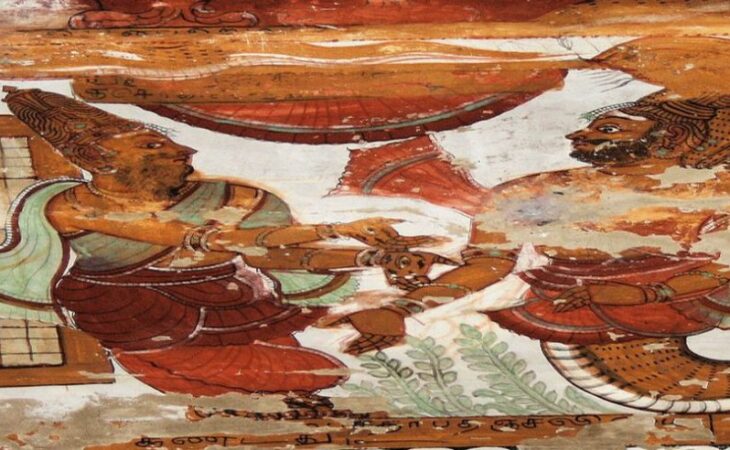Patanjali ‘s Mindfulness- The 7 Steps to Self-Fullness
Raghu Ananthanarayanan 20 May, 2022
Who centres the universal wheel?
How may we touch this centre in our selves?
The divine manifests itself in order and rhythm, we touch the divine when we experience order within. How do we learn to live with order and rhythm so that the divine may manifest itself in our lives?
These are great questions to ponder over.
Patanjali says that we can live our life in a way that enables us to embody the answers to these questions. This is the Yogic quest.
Patanjali sets out for us a set of practices through which we can transform our everyday life into one that is full of truth and beauty. These practices start from mindfulness directed to our everyday interactions. They move through stages, each of which becomes firm ground from which we can ascend to the next step. Each step is a deepening and strengthening of the mindfulness practice. The practise becomes a way of life, and this constancy of mindfulness prepares our psyche to invite the transcendent Self to shine through us. Our small self fades away, we become Self- full.
Sankhya and the Idea of Mindfulness
The Sankhya Karika introduces a few very important ideas that relate to mindfulness. Firstly that the means of ending duHkha is through a “discriminative observation of the Manifest, the Unmanifest and the Seer.” (vyakta, avyakta gnya vignyAna– Karika 2)
In Karika 7 Sankhya speaks about the reason why the accurate and exact perception of “what is” does not happen. It states that the object could be too distant (atidUrAt) too close (sAmEpyAt); the senses could be malfunctioning (indriyaghAtAt) or the mind could be stressed (mononavsthAnAt); the object could be too subtle (saukshmyAt) or too large (vyvadhAnAt); it could be hidden (abhibhavAt) or indistinguishably similar to another (samAnAbhihArAt).
The third very interesting idea is that of adhyavasAyo buddhi. (Karika 23) This is a state of mind where the three components of the mind namely buddhi, ahamkAra and manas are perfectly aligned. This mind is cleaving to the truth of “what is” with blinding insight.
Sankhya also discusses many other very basic concepts like cause-effect, the transformation of mUla prakrti into the manifest object world and the guNa that form the primordial prakrti as well as the puruSha. But, after stating “why” one must practice mindful and discriminative observation and indicating “what” one might discover, does not discuss the “how”. To understand how one must study the Yoga Sutra.
Mindfulness in the Yoga Sutra
The Yoga Sutra is replete with ideas on how to develop a mind that is capable of discriminative awareness which it calls dhyAna, and how staying with dhyAna enables the mind to achieve deeper states of attentiveness and insight through samAdhi. samadhi is further elaborated upon and the finest state of the mind is called kaivalyam. There are many Sutras in every chapter that approaches dhyAna from different starting points. Each of these starting points was meant to enable a mind with particular kinds of capability and intelligence to take up the practice.
In this paper we examine just one sutra: tasya saptada pranta bhUmiH prajnya.(Chapter 2- 27). We can use this sutra as the window through which to understand all the practices enumerated across the 4 chapters. It is important to keep in mind that this sutra is an elaboration of what the YS calls the hAna upAya i.e., the intelligent practice that enables one to discriminate between the ever-changing and manifesting prakrti and the changeless and Intelligent puruSha.(Chapter 2- 26). This practice is called viveka khyAti. The realisation of the true nature of the Self or Consciousness or Intelligence (whatever one chooses to call this entity that is beyond the chitta) happens almost as a spin-off of the primary focus of viveka khyAti, namely the ending of duHkha, and all traces of vAsana and bhaya that cause prakrti to keep re-entering the process of manifestation (pratiprasava).
The first step is called ‘kArya vimukti’, mindfulness that leads to a freedom from actions that create duHkha. Patanjali says that anxiety or bhaya, causes us to become mindless. Mindlessness happens when our inner compulsions take over the psyche. The seeds of vAsana become full blown and the energy of the vAsana colours every paramAnu of our being. Our psyche responds to the restlessness that anxiety creates, and we only look for solutions and refuges. An anxious mind is also a mind that is in avidya. Patanjali says that avidya is an erroneous perception that leads to duHkha creating action. So the very compulsion to seek the way out becomes the process of grasping called phalApeksha. Thus the cycle of bhaya, triggering duHkha, which in turn triggers rAga and dveshaH, reinforcing a false idea of self (asmita) which is grounded in avidya and seeks to reinforce this constructed self (abhniveshaH) is kept energised. Awakening to the reality that one is in duHkha and being mindful of the types of bAhya/ avidya that cause obstruction is the first step. In the second chapter, the YS suggests ways like yama and niyama to enable the sAdhaka to create a bulwark against the external forces that trigger and reinforce this negative cycle. yama and niyama then become a protective scaffolding that enable the sAdhaka to dismantle the distorted prAnic inner form and allow a new well-proportioned flow of the inner energies to happen.
I am mindful that I am in Avidya, and pay attention to the ways in which I relate to my world.
The second step is called ‘chitta vimukti’. By directing our mindfulness to the causes of anxiety that lie deep within our minds we free ourselves from repeating behaviours that cause duHkha. The relative calmness created by protecting oneself from outer distractions is used to redirect ones attention. Asana practice reduces the rajas that drives the body/ psyche and prANAyAma reduces the tamas in the body/ psyche. The objects of attention are the sensations that arise from the body/ psyche. These sensations are the sprout like a form of the vAsana awakening (tanu) and en-route to becoming compulsive fully blown actions (vicchinna udAra). The heat of the observation (dhyAna agni or prasankyAna agni) burns the energy of the seeds and they become weakened till they are burnt away (dagdha bEjam).
My mindfulness generates insight into avidya and impediments to clear perception that is the cause of my sorrow.
The third step is called ‘adhikAram’. The mindfulness practice that frees us from the impediments that arise in our thought and feeling patterns also ends our craving for external objects. This energy that drives desire becomes a yearning for experiencing samAdhi. At this stage of the practice, one can disengage with the outer with great ease (pratyAhAra). dhAraNa on the process of the mind becomes possible. This feeds the sAtvic energies and one’s observation becomes more and more acute. The mind starts to sense the process by which the quiescent pradhAna is manifesting in the world and yearns for enlightenment.
Through the deepening of mindfulness, I have a glimpse of the true nature of puruSha, the Transcendent Being and of prakrti, Nature.
One of the keys to mindfulness that enables us to take the first three steps is sakhi bhAva: observing ourselves with the penetrating gaze of an affectionate friend.
I own up to the discoveries I make of my own psychological process with compassion.
One is now ready to enter a decisive fourth step called ‘viveka khyAti’. This is the level of mindfulness when the yearning for samAdhi is converted into a discipline and uninterrupted practice. The practice is not divorced from one’s living process. This level of mindfulness is the firm grounding of sakhi bhAva, the dispassionate and detached but incisive attention to all living processes. The ability to stay with an enquiry with shraddha and vEryam get firmly established. When this enquiry becomes subtle, one can see how the vAsana were generated and how they manifest as samskAra that engulf the psyche/ body. One can go back to experiences in the womb, early childhood and even into a previous birth.
I am mindful of myself and my world with unwavering discrimination.
Mindfulness now becomes a spontaneous way of being in the world. This stage is called ‘gurushikharam’, “the top of the hill falls off like an avalanche”. The mindfulness practise now has its own inertia and it will create the conditions for one to receive grace. This practice takes one to the edge of clarifying all the residue in one’s buddhi, the most subtle parts of one’s mind. All mental constructs of the self fall away. One has the opportunity to select the path with a heart (abhimatam) for dhyAna. Extraordinary subtlety of the psyche also means extraordinary capabilities. One is warned against letting the remnants of vAsana awaken. This will then destroy all the gains on the path.
I now live my life with a sense of deep awareness, order and rhythm.
Mindfulness is no longer a practice, it becomes subtle and deep, and pervades every aspect of my life. This is called ‘astam’, “the hill crumbles so that it cannot rise again”. The constancy of mindfulness roots out all the impediments, old habits and residues in the psyche. At this point even the wish for mokSha, liberation falls away. All bhaya ends completely, one can witness the origination of one’s mind.
I live with great intensity, insight and integrity.
Just as a river flows to the sea calmly and with great dignity, all sense of self falls away. This is the final stage called ‘atEtaH’. The ego is a construct of one’s mind. Unresolved rajas and tamas are the building blocks of this constructed self. The psyche is cleansed of all traces of rajas and tamas. It becomes shuddha satvam. With the dissolution of the self one’s mind is in a state of pragnya, it reflects “what is” with perfect clarity like a brilliant crystal ball. One can witness the very origination of all of manifestation (kshaNa pratiyogi).
My small self is not there to veil the light of puruSha who can now ‘shine’ through me with its Intelligence.
I am a part of the universal wheel.
I manifest the luminosity of this centre.
My life is replete with order and rhythm, the divine manifests itself through me.
(Cover Photo: Image courtesy Google)
Disclaimer: The opinions expressed in this article belong to the author. Indic Today is neither responsible nor liable for the accuracy, completeness, suitability, or validity of any information in the article.


